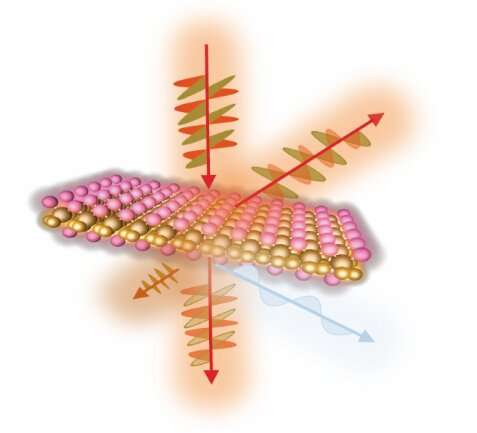Ultrathin vanadium oxychloride demonstrates strong optical anisotropic properties


The optical, electrical and mechanical properties of some materials change depending on the direction or orientation of the material. Depending on how wood is cut, for example, the orientation of the wood grain can result in a stronger or weaker material with different appearances. This same principal applies to ultrathin, two-dimensional (2D) materials with unique properties such as magnetism.
Depending on the direction of a mechanical strain placed on one of these materials, the magnetic properties of the material change. This may facilitate the design of unique magnetic strain sensors that can convert force into a measurable electrical change. And while the anisotropy of the magnetic, mechanical, optical and other properties of these materials can, in theory, be predicted, the predictions must be supported or rejected based on empirical measurements to determine the true suitability of a material for a particular application.
A recent study led by scientists at Beihang University was designed specifically to experimentally assess the physical properties of ultrathin vanadium oxychloride (VOCl) because of its potential suitability for various nanotechnologies based on theoretical calculations. The research team systematically characterized the directionality of the optical properties of the 2D material in response to the arrangement of its atoms, using polarized light. The findings are reported in the January 5, 2023, issue of Nano Research.
The researchers synthesized bulk VOCl and mechanically separated the material into few-layer, nanometer-thick samples to assess the optical characteristics of 2D VOCl from different directions. Once the team established the atomic microstructure and composition of the synthesized VOCl, experiments were performed by shining polarized light on 2D VOCl samples rotated at different angles. The researchers determined how in-plane optical brightness, absorption, reflection, crystal orientation and symmetry of the ultrathin material changes due to its atomic structure and the angle of light directed at the sample.
Together with ultrathin VOCl’s predicted magnetism, the optical anisotropic properties assessed during the study will help determine the suitability of 2D VOCl for use in future nanotechnologies.
“These results lay a solid foundation for 2D VOCl in the applications of spintronics and optospintronics,” said Chengbao Jiang, professor at the School of Materials Science and Engineering at Beihang University and lead PI of the research team.
Spintronics is an emerging technology that uses the spin of electrons to code information, speed data processing, increase circuit density and decrease energy consumption. A newer branch of spintronics, called optospintronics, uses optics, or light, to either measure or control electron spin.
“These optical anisotropic properties can be utilized to design novel functional devices, including photodetectors, linear-polarization light generators, strain sensors and artificial synapse devices,” said co-lead author Shengxue Yang of Beihang University.
VOCl, which forms a crystal structure of vanadium, oxygen and chloride atoms, is only one of many materials that can be mechanically separated into ultrathin layers and demonstrate directionally and orientationally dependent physical characteristics. Graphene, a single layer of carbon in a honeycomb structure, and black phosphorus, a material that is structurally similar to graphene but is instead composed of phosphorus atoms, have both been characterized for their strength and ability to conduct heat and electricity, with black phosphorus potentially serving as a replacement for more toxic graphene in biomedical applications.
While the physical features of 2D materials are often theorized through predictive calculations, ultrathin materials must be characterized empirically to confirm their mechanical, optical, magnetic and other properties. Experimental results often align with theoretical calculations and can be used to confirm both the quality and composition of the synthesized material. With empirical confirmation of the ultrathin material’s physical properties, unique features can be leveraged for the emerging nanotechnology applications of the future, including quantum computing, force sensing and energy storage.
More information:
Tianle Zhang et al, Strong in-plane optical anisotropy in 2D van der Waals antiferromagnet VOCl, Nano Research (2023). DOI: 10.1007/s12274-022-5358-0
Provided by
Tsinghua University Press
Citation:
Ultrathin vanadium oxychloride demonstrates strong optical anisotropic properties (2023, January 6)
retrieved 6 January 2023
from https://phys.org/news/2023-01-ultrathin-vanadium-oxychloride-strong-optical.html
This document is subject to copyright. Apart from any fair dealing for the purpose of private study or research, no
part may be reproduced without the written permission. The content is provided for information purposes only.



